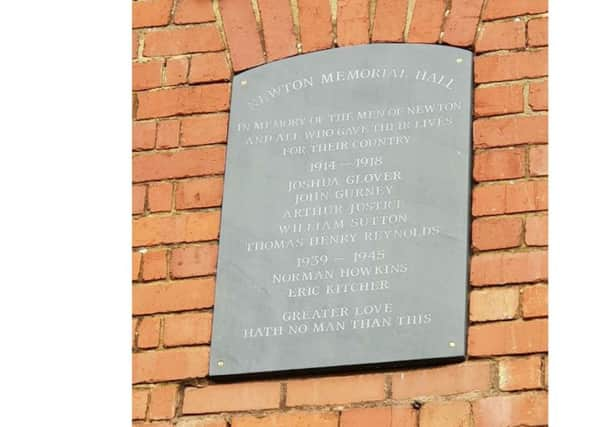LOOKING BACK - November 15, 2018 edition


So many of you have been kind enough to contribute World War I and Armistice related photographs and pieces for Memory Lane, that we will be continuing the theme for the next few editions.
Thank you to Noel Barratt, who has written the first of these, following Sunday’s service in Newton:


Advertisement
Hide AdAdvertisement
Hide AdThe Village Hall in Newton was built in 1923 in grateful thanks for five men of Newton who gave their lives in World War I and now, 100 years later, a permanent slate memorial is fixed on the building. The two men who died in World War II are also being included.
All the men have been identified, through their local family connections where possible, their place of death and where they are commemorated.
The new War Memorial plaque was dedicated during a short service led by Revd Canon Ted Lyons, and included the exhortation spoken by Fred Jenaway – a life member of the British Legion who served in the Parachute Regiment in the Middle East and Germany. The response was led by a members of the Newton Guide Company. The Last Post and Reveille were played by Henry Corbin. Henry, aged 9, plays with Bilton Silver Band. We were also pleased to welcome relatives of two men who died. The number of people attending the service exceeded 150, more than double the number expected.
The family history of each man has been traced, especially in the period before the war and what happened to the families they left behind. There was a small exhibition showing records on each man and his family. Further details, including the war diary entries for the relevant periods told something of the horrors they faced and the price they paid.
Advertisement
Hide AdAdvertisement
Hide AdThomas Henry Reynolds died on the 12th August 1917 aged 37. His brother also was killed two weeks before him. They left five sisters in Rugby and we were pleased to meet two sisters who know them as their great uncles. Thomas’ wife ran the village Post Office so giving us another point of memory.
Eric Kitcher moved to the village in 1920 from Lancaster with his father and mother, Thomas and Florence, and his brother Arnold and sister Ettie. Thomas moved here to work on the railways.
Eric joined the RAF (VR) early in World War 2. He was based in Norfolk and died there in June 1942 when the bomber he was in crashed soon after takeoff. His daughter, Margaret, had been born in May 1942 and Eric had been on leave for the birth. We were pleased to welcome Margaret together with Pat and Geoff, the children of Ettie. They were able to pay their respects at Clifton Churchyard where Eric is buried.
The village came together to create points of remembrance throughout the village.
Advertisement
Hide AdAdvertisement
Hide AdOver 125 ceramic poppies made and painted by local hands have been laid to mark 100 years and placed in front of the Village Hall. Outside the Good Shepherd Church stands a cross covered with poppies made from crochet and needle work. Flanking the cross is a trench symbolising the countryside where these men fell. Seven street signs, one for each man, plus others representing the World Wars, have been fixed around the village. Two soldiers stand guard as you enter the village, one at each end.